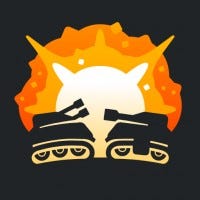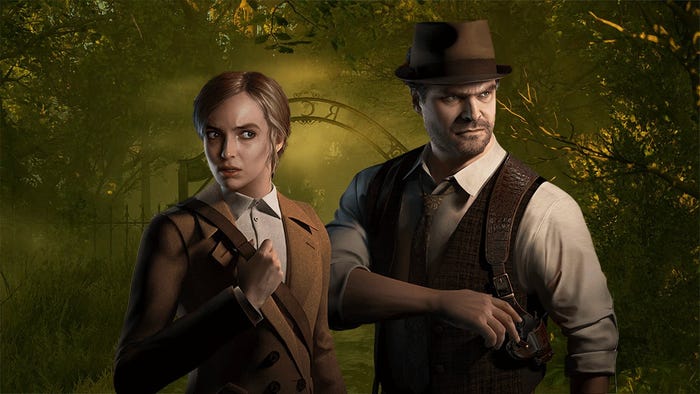
Featured Blog | This community-written post highlights the best of what the game industry has to offer. Read more like it on the Game Developer Blogs.
RTS design that resonates with players puts the agency of the player first. Such design gives players ample room on which to succeed or fail own their own merits and it will give them multiple arenas in which to succeed.

Originally posted on http://waywardstrategist.com/2016/02/17/rts-design-thought-control-of-tactical-outcomes/
I have this theory I’ve slowly been developing about RTS games design. I touched on it briefly in my overview of action RTS AirMech, and again in my first “RTS Design Thought” article where I briefly discussed the implications of economic automation. I suppose I need to, at some point, sit down and write it out in full, in bald words, but I am unsure I’m prepared at this point to commit it to writing in that way. So, for now, I’ll continue to reference it and dance around its circumference in a partial and fragmentary way, by discussing another of its facets: the implications of a player’s ability, or lack thereof, to meaningfully influence the outcome of tactical play (mostly, combat interactions) .
That was a bunch of flowery language, but in short: good RTS design, RTS design that resonates with players, puts the agency of the player first. That is, such design will give players ample room on which to succeed or fail own their own merits, and it will give them multiple ‘hooks’ on which to hang a victory; that is, multiple arenas in which to succeed and to drive efficiency and effectiveness in their play. One of the most effective tools for this has, traditionally, been in games’ combat systems.
What Does It Mean To Have “Control of The Outcome” in RTS Combat?

There are a number of ways to define what it means to have control of the outcome of a combat interaction in a real-time strategy game. For the purposes of this article, however, let’s look at it this way: first, that the player’s actions during combat can influence how successfully the combat goes for that player. This is related to, but separate from, how successfully the player has prepared for the combat interaction. For instance, in Relic’s Company of Heroes titles (as an example), setting up for combat includes positioning vehicles, mortars, set-up weapons such as MGs/AT guns and infantry to ensure an advantageous engagement. Going back even further, being able to intuit and determine the enemy’s plan and to actually produce the units which increase the chances of overcoming the other players’ force composition and engagement strategy are essential as well. In combat, keeping critical units out of harm’s way while dealing maximum damage with one’s own combat resources provides the third leg of this tripod.
So, “control of the outcome” encompasses 3 major factors: force position, force composition, and ability to leverage control of one’s units (also commonly called micro) to drive efficiency in combat (e.g. killing more resources worth of enemy units than one loses, or retaining/gaining control of critical territory).
There is, however a fourth element to the overall gestalt picture of “control” – the ability to disengage or minimize losses in some way should combat go poorly. This fourth element increases in importance as the size of one’s forces – and the percentage one must typically commit to a combat operation – increases. The harder it is, generally, for a player to reacquire or preserve lost combat resources (units, mostly), the more important it generally is that some system be provided to preserve or reacquire those resources.
It is also important to have nuanced loss and victory states in RTS combat, just as it is important to have nuance in economic control and management systems. I’ll continue on with this after a brief break to discuss an important concept: the “skill floor” and how it relates to nuanced control (tl;dr – reliance on player APM, as StarCraft does, is the simplest way to allow nuance, but it’s far from the only way to introduce it)
A Brief Interlude To Discuss the ‘Skill Floor’
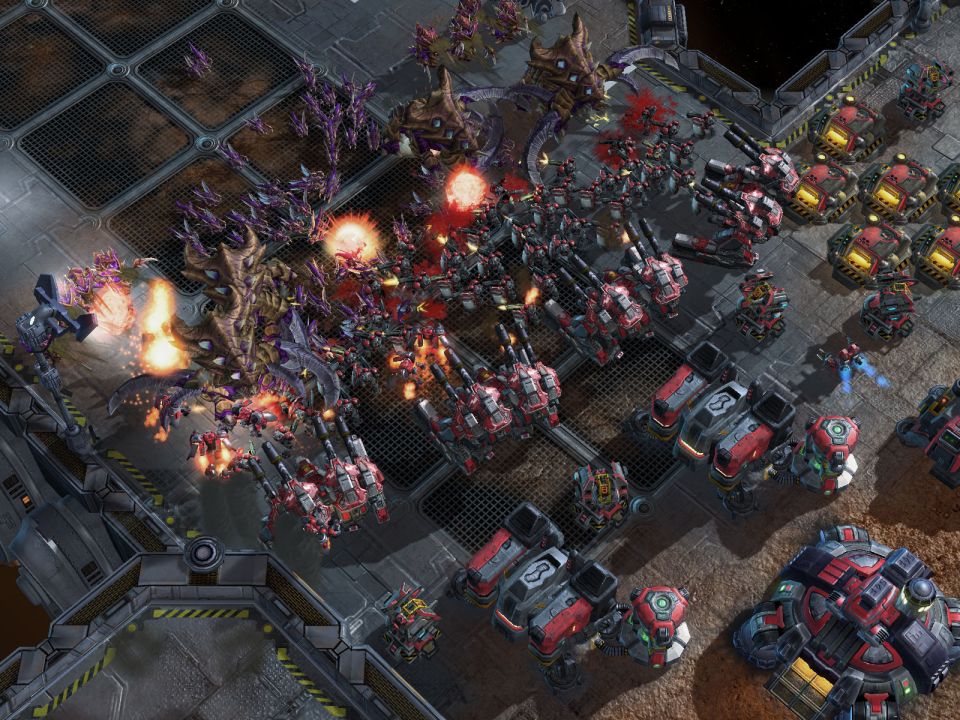
Please note, I don't feel that I've done the topic of the "skill floor" justice in this piece and plan to write about it more in future articles. I hope my meaning is able to shine through my muddled words.
This entire line of thinking goes hand-in-hand with the much-discussed and incredibly controversial topic of APM requirements, or as I like to call it, mechanical burden the game puts on players.
Ultimately, mechanical burden is a deviously double-edged sword. In the first case, as we see in many popular RTS franchises such as StarCraft/WarCraft, Command and Conquer and Age of Empires, virtually every aspect of the game allows the player to drive efficiency and increase productivity. Whether it’s fiddling with Harvester capacity and return timing, or SCV saturation of mineral lines, expansion timing, scouting, army ‘dancing’, harassment runs… there’s always some little new thing that the player can be doing, always room for continued fractional improvements.
These skills, it’s easy to argue, can put an incredible and in some cases intolerable burden on the player. We saw, for instance, in Legacy of the Void, the partial simplification of the Zerg ‘Spawn Larva’ mechanic and the Protoss ‘Chrono Boost’ mechanic as one sign of Blizzard’s acknowledgement that such mechanics can be overly fiddly, not interesting or engaging, and overly demanding of the player’s time and attention. The problem, if the term may be accurately applied, with StarCraft remains the same as it’s greatest benefit.
There’s too much to do and too much to keep track of.
The genius (again if the term may be accurately applied) of StarCraft’s design is that it asks so much of the player that it allows players of varying strengths to succeed in their own way. It is possible to win, however frustrating the loss might be for one’s opponent, with a single Banshee, or a single Reaper, or Dark Templar against an unprepared opponent. Such play allows players with good “micro” skills to succeed against players with more polished economic growth abilities.
Now, the issue is, while StarCraft provides ample room for players to float at their own level, it also punishes players for incredibly minor errors in execution in any arena. And this is the double-edged-sword of the skill floor.
Games like Relic’s Company of Heroes and Dawn of War series, or Cavedog’s Supreme Commander or Uber Entertainment’s Planetary Annihilation, or Stardock’s Sins of a Solar Empire and (potentially) Ashes of the Singularity have a variety of other methods for players to succeed in multiple arenas, through different types of fine control. These other games, in their various ways, strain the player’s attention without resorting to the mechanical demands of APM requirements.
The goal is always to provide nuance and allow the player to have as much agency as possible, not strictly to force/allow them to perform ever-escalating numbers of actions within a specific time frame. RTS will always have some level of mechanical demand, but both small scale tactical combat games like Company of Heroes and large scale games like Supreme Commander have implemented systems which are less dependent on APM/mechanical burden to drive player success.
Experiments in Nuanced Tactical Outcomes

(Why Act of Aggression? I’ll get to that in a bit.)
We’ve already discussed StarCraft somewhat in relation to tactical successes: it actually misses the mark somewhat, in my opinion, in that in many cases it’s quite difficult to disengage in combat and/or recoup losses leading to incredibly binary situations where a single bad combat engagement can lose one player the game (not optimal) but it comes pretty close in several aspects, especially in controversial decision to create units with enough speed and power to completely wreck an opponent’s economy and win games through “micro.”
The value of this could be argued both ways: in the one hand, it’s certainly providing a plethora of “hooks” on which to hang a victory. On the other hand, such design can be seen as putting undue burdens on defending players. It’s a delicate balance and StarCraft has chosen to err on the side of complete and total devotion to player agency.
Other games, mentioned above, approach this in various other ways. Company of Heroes 2 has a incredibly nuanced combat system that allows for almost infinite gradations of ‘success’ and ‘defeat’ – if the player has the wherewithal to capitalize on the systems it provides.
In the Dawn of War and Company of Heroes games, units are grouped into squads of between 1 and 8 individual units. I’ve heard lots of reasons for this, one of the primary being that “it decreases required micromanagement” and lowers the skill floor for players. In this writer’s humble opinion, this is exactly wrong. What this does is actually increase, in conjunction with the ‘Retreat Button’ the nuance of the combat system.

Since each model within the larger unit contributes to the hit points and the damage output of a unit, it is possible for an enemy to be partially successful in “killing” a part of a unit, decreasing its performance and forcing the player to return to base for repairs. Morale is another way to impact infantry units, with units like snipers and MGs damaging models as well as morale, allowing non-binary loss of efficiency and loss states. Losing a squad in Company of Heroes or Dawn of War games is incredibly non-trivial, but there are a vast array of other loss states possible, ranging from being pushed off the field temporarily to having to rebuild a squad, weapons and all, up from a single remaining trooper.
Similar nuance is incorporated into the vehicle system with the inclusion of damage states that can disable weapons, lower movement speed and turn rate and more. With Relic’s system, being put out of commission or forced to retreat is a lesser failure to being killed outright, and this has proven to be a monumentally successful system in providing nuance.
One of the cornerstones of this model, however is the Retreat Button. This allows the player to have tons of control over their commitment to combat, and whether their units are preserved, while allowing their opponent to attempt to kill off retreating units (sometimes via putting high damage units along escape routes). Without the Retreat Button, it is arguable that the entire Company of Heroes/Dawn of War combat system would entirely fall apart, as players would be unable to disengage and attempt to preserve their forces to fight another day.
Another key element of this system is the geographical and nuanced nature of victory points and resource nodes. There is value in removing enemy control of a point, and there is value in capturing such a point for a short while.
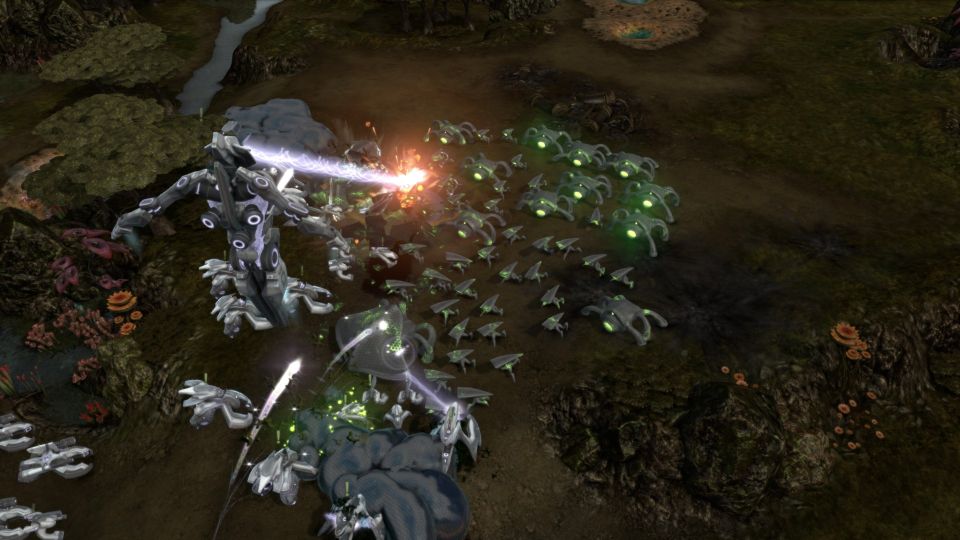
Let’s switch gears for a moment and talk about some of the more recent RTS to come out: Homeworld Deserts of Kharak, Grey Goo and Act of Aggression. Where do they fall on this spectrum?
Grey Goo, sadly, doesn’t stack up well here at all (or didn’t before the release of Descent of the Shroud). With the relatively slow pace of unit movement, disengaging or otherwise preserving or reclaiming the investment of units is incredibly difficult in a bad situations, allowing combat to rapidly spiral out of control for a player caught in a bad engagement. Individual units, with the possible exceptions of some aircraft and Epic units, have very little ability to benefit from nuanced control, meaning that ‘micro’ plays a relatively small role in combat (indirect fire units are an exception here but even then they have a very hard time making up for great imbalances in unit quantity). Economy can be a salvation here, as in StarCraft, with one player churning out enough units to keep an enemy advance at bay, but often once a player falls behind economically it’s pretty much “all she wrote” in Grey Goo with few exceptions (some tech switches can help with this, on occasion). Grey Goo doesn’t have a good support system to prevent or mitigate ‘slippery slope’ losses, which I think is a major reason it has failed to catch on with players in a broad sense. I am glossing over this for brevity, I know that there are a plethora of counter-examples and a lot more analysis that can be done on this system, and on Deserts of Kharak’s.
I still find Grey Goo to be enjoyable, and it remains one of my most played RTS, but in terms of economic and tactical nuance, it’s getting in its own way more often than not.
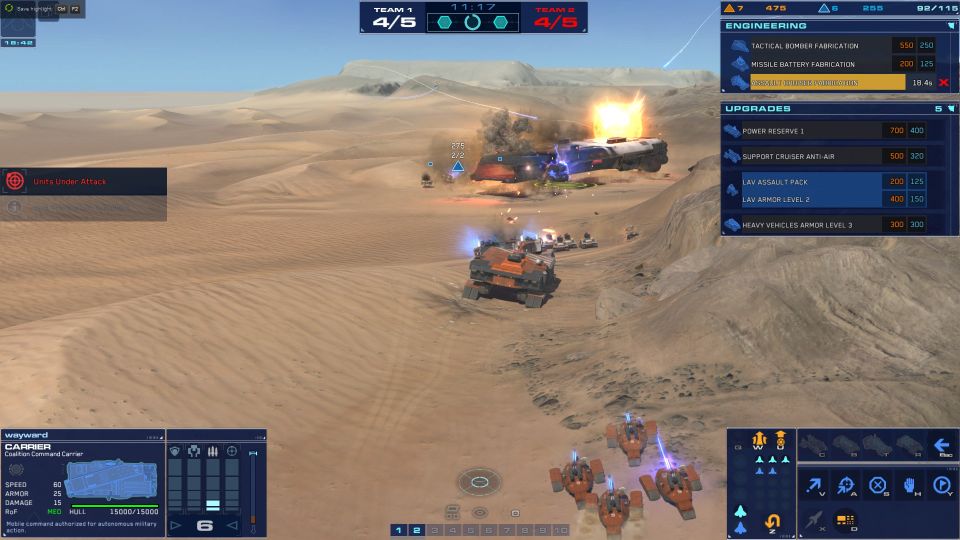
Deserts of Kharak is in a somewhat different position. It has more of the spirit of a Dawn of War or Company of Heroes, with terrain bonuses having impact on units’ ability to engage, and the effectiveness of combat engagements. However, its ‘failure states’ in combat are harsher than in Company of Heroes games, with the player on the back foot having a very difficult time disengaging or getting out of a bad combat situation. Additionally, with fewer ‘points of interest’ or regions in contention on 1v1 maps (I haven’t tried the new map out yet sadly) there is less nuance in map control. Combine this with a 5 point victory condition (each Artifact is 20% of a win) that has a very binary win/loss mechanic, and you have a set up that is, arguably, not giving players as much room to succeed as Relic’s system.
I don’t say this to disparage either game, but instead to illustrate my position. I enjoy both of these games very much, but feel that the above are reasons they have failed to resonate with their multiplayer communities. The more control (to an extent, but that’s probably a topic for a future article) players have of their own destiny, and of the outcomes of their strategies, that players are given, the better the game will ‘feel.’ This is why games with nuanced systems, such as StarCraft, Company of Heroes, and Supreme Commander have such resonance with players: nuanced control of the tools the player is given, and a wide variety of tools with which to succeed.
This article is already getting unsupportable in length, but I’d like to briefly address Act of Aggression and Ashes of the Singularity before I conclude.
One of the things I actually think Act of Aggression does best is to provide players with a variety of tools to succeed in combat. Its combination of unit speed, range and capabilities, along with an upgrade system that Bruce Geryk rightly criticized for “giving all players the same toys” (I’m paraphrasing here, sorry if I’ve misquoted him), Act of Aggression actually leaves players always feeling, tactically at least, that they have room to maneuver, and options. The issues with this game stem, in the humble opinion of this writer, from an obtuse tech tree, frustrating economic requirements, and a game that changes completely once resources are mined out (which happens pretty quickly). But as far as combat interactions go, players are given lots of room to be successful, and to make up for tactical missteps and miscalculations. If the game can address the other issues (and there are sadly, several major obstacles in play), its combat system can actually support interesting, meaningful play. One of the biggest hurdles, however, to reinvigorating Act of Aggression is that one of the reasons the combat system is so flexible is that units are, effectively, watered down. Altering this without simultaneously stripping players of options is a tall order.
The Nuance of Scale

One of the strengths of large scale RTS is that in some ways they are immune to many of the issues addressed in this article. Their scale precludes ‘micro’ battles, at least going into the mid-game, while simultaneously introducing nuance in the form of force composition. In much the same way that units in Company of Heroes provide nuance through fractional success and failure states, with hundreds of units, it’s possible to craft damage profiles and armies in a plethora of ways that are tactically and strategically significant. Large scale games tend to resonate as they have both economic and tactical nuance baked in part and parcel with their scale.
Systems like Supreme Commander includes, with different structure adjacency providing different benefits to production and resourcing structures, and the ability to further drain resources (driving inefficiency with resources but efficiency in production) by committing additional Engineers to a construction project, by their very nature provide players with experientially (if not necessarily actually) different paths towards success. Thousands of words could be written on this topic, I am sure. But I’ve already drawn on too long, I am afraid. Suffice it to say, scale in RTS comes with many possibilities for the introduction of meaningful nuance, though it limits (for good and ill) the impact of any single decision a player makes.
In Conclusion (?)
Last time, I talked about economic nuance. This time, I attempted to define, or at least circumscribe and outline, tactical nuance. These are only 2 pieces of a larger puzzle. Unit and faction design , and by extension a game’s counter system, play an enormous role in combat and I scarcely touched on that in this article (though again, the outlines are present, if you read carefully). My bottom line is this: the goal is to give the player freedom to succeed or fail through the efficiency of their actions, to allow them numerous ways to be successful, and to give themselves an “out” when things turn south, even if their backup strategy is incredibly risky.
Thanks for your time. If you have any thoughts about this article or about my larger theory on RTS design, please do share it with me.
Read more about:
Featured BlogsAbout the Author(s)
You May Also Like

